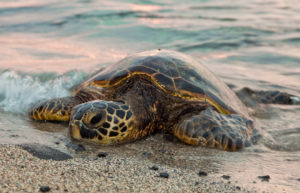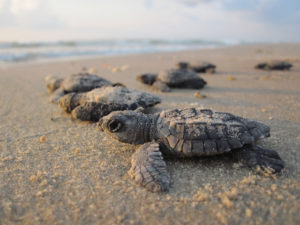Turtle Facts
Sea turtles are among our most precious natural resources.
 Saltwater reptiles, they are graceful and well adapted to life in our oceans. Their aerodynamic bodies and flipper-like limbs enable sea turtles to cover great distances in the water in comparatively short periods of time. Active sea turtles will swim every few minutes to the oceans’ surface to breathe. During resting periods, the turtles can remain underwater for up to 2 hours without breathing.
Saltwater reptiles, they are graceful and well adapted to life in our oceans. Their aerodynamic bodies and flipper-like limbs enable sea turtles to cover great distances in the water in comparatively short periods of time. Active sea turtles will swim every few minutes to the oceans’ surface to breathe. During resting periods, the turtles can remain underwater for up to 2 hours without breathing.
Sea turtles once roamed the oceans by the millions but over the past few centuries the demand for sea turtle meat, eggs, shell, leather and oil has greatly reduced their number. Turtle populations will continue to decline because of the trade in sea turtle products and because of the loss of essential habitat. Concern for the plight of sea turtles is growing and around the world, conservationists, governmental agencies, public and private organizations, corporations, and concerned individuals are working to protect sea turtles on nesting beaches and at sea.
Each summer, Florida beaches host the largest gathering of nesting sea turtles in the United States.
 The adult females emerge from the surf to deposit eggs in sand nests and later, tiny hatchlings struggle from these nests and scramble to the ocean. Nearly all of this activity takes place under cover of darkness.
The adult females emerge from the surf to deposit eggs in sand nests and later, tiny hatchlings struggle from these nests and scramble to the ocean. Nearly all of this activity takes place under cover of darkness.
Even though sea turtles are at home on the oceans, they are inextricably tied to the land too because the adult females must return to land to lay their eggs in a sandy beach. Scientific research has shown that the female turtles return to nest on the same beach where they were born. While the turtles often must swim long distances from their feeding grounds to their nesting beaches, just how they find their way to that nesting beach is still unknown.
From the middle of June till the end of October, eggs buried on the beaches of South Florida will spring hatchlings that dig their way out of the nest and race toward the ocean waters. During nesting season, turtles produce as many as 15,000 nests a year in Palm Beach County. About 1 million turtles emerge, about 50% to 70% of the total eggs laid, but researchers believe only 100 to 1000 survive to sexual maturity.
Did You Know?
- The temperature of the nest determines a hatchling’s gender. Warmer temperatures produce mostly females, and cooler temperatures produce a majority of males.
- Nesting sea turtles return to lay eggs in the same general region where they are hatched.
- Roughly one quarter of all sea turtle nestings in Florida occur in Palm Beach County, making our beaches extremely important to the survival of these threatened and endangered species.
